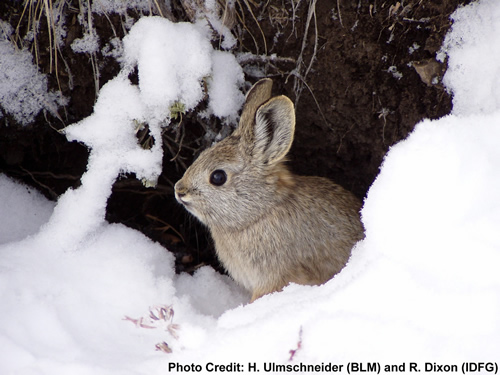
A pygmy rabbit in this winter photo
Time to Give Up?
by Larry Hyslop

A pygmy rabbit in this winter photo
The Columbia Basin pygmy rabbit is highly endangered. Pygmy rabbits across the West are doing fine, but not this sub-species found in Douglas County of Washington State. Pygmy rabbits are our smallest rabbits, with adults weighing about a pound. They need deep soil beneath tall sagebrush, where they dig their deep burrows.
In 2001, 16 rabbits were gathered to begin a captive breeding program at the Oregon Zoo. No Columbia Basin pygmy rabbits are known to survive in the wild. Among the offspring of those captive animals, the last purebred male recently died. Only two pure bred females survive at the zoo.
I stress purebreds because of one strategy being used to maintain this sub-species. They are being cross-bred with closely related, Idaho pygmy rabbits. The goal is to maintain a population where 75% of their genetic code comes from the Columbia Basin pygmy rabbits. The U.S. Fish and Wildlife Service has determined that these crossbred rabbits will count as recovery of the Columbia Basin pygmy rabbit.
The biggest problem with this strategy is that pygmy rabbits breed poorly in captivity, which explains why the original 16 captive rabbits declined to only two remaining purebreds. It has also been controversial since Idaho pygmy rabbits are not endangered, other than those few unlucky individuals who have arrived at the Oregon Zoo.
A second strategy consists of releasing crossbred rabbits back into the wild. The problem is they know nothing of predators, having been raised in captivity. A similar release in 2007 failed, since the released rabbits were all killed. This time, a six-acre enclosure has been constructed among the sagebrush of Douglas County. Its six-foot tall fence has an electrical wire along the bottom to keep predators from digging beneath the fence. The fence posts are topped with spikes to keep raptors from perching on them. It is hoped such precautions will keep out coyotes, badgers, weasels, snakes and at least discourage birds of prey.
The enclosure contains artificial and actual pygmy rabbit burrows, where animals will hopefully live and breed. Later, rabbit couples will be moved to smaller enclosures, where they will slowly be allowed access to tunnels leading to the outside world, and will hopefully someday resort to being wild rabbits.
The problem is much of their habitat is gone, having been converted to farm land. Seven distinct populations of Columbia Basin pygmy rabbits died out quickly and at the same time, from habitat loss plus other, unknown reasons. Researchers have spent approximately two million dollars over the last ten years on this recovery program.
While I would normally say we should always fight to save a species from extinction, when do we give up on one crossbred sub-species with little remaining habitat, and focus more of our time and money on other species?
Elko Daily Free Press, “Nature Notes”, 6/24/2011
© Gray Jay Press, Elko, NV
Return to Elko Nature Notes